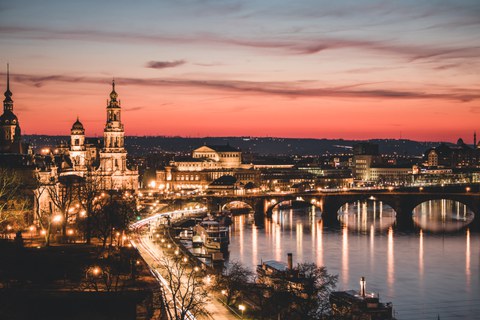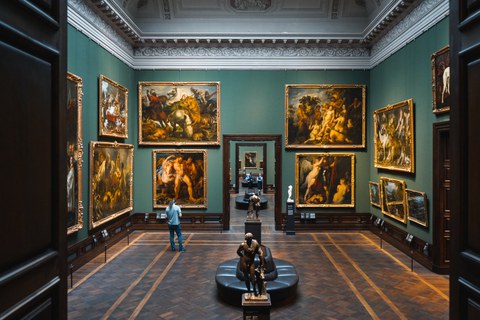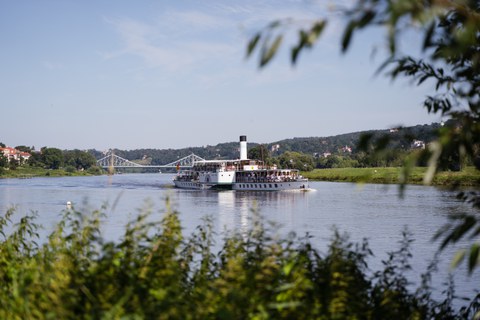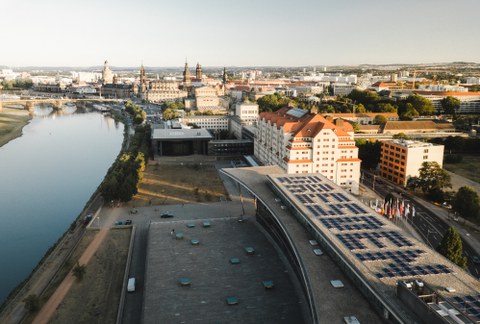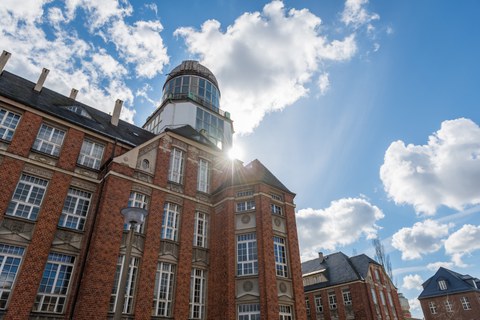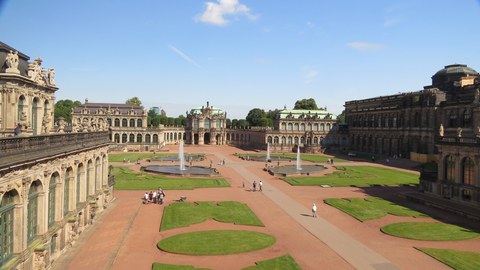Destination Dresden
Dresden – City of Excellence
Located at the foothills of the "Erzgebirge" (the ore mountains) and the "Elbsandsteingebirge" (Elbe Sandstone Mountains), Dresden is the capital of the Free State of Saxony, one of the 16 federal states of Germany. Home to approximately 570,000 residents, it is the country’s fourth-largest city by area after Berlin, Hamburg and Cologne.
Dresden is situated at the banks of the scenic Elbe River, which winds through the town over length of about 30 kms. Nine bridges provide crossing points over the river, amongst them masterpieces of engineering such as the "Blaues Wunder" (blue wonder) . With 62 percent of its area covered by forest and green space, Dresden is one of the greenest cities in Europe: The city limits enclos 3 nature sanctuaries, 11 landscape conservation areas and 112 natural monuments, in addition to numerous public parks.
Culture & Sights
The old Saxon residence Dresden is an artistic and cultural center of international significance. Its cityscape is characterized by monuments spanning from Baroque masterpieces to landmarks of modern architecture. World-famous art collections and museums as well as a lively scene of contemporary art, music and theatre make it a bustling cultural hub - all set within the beautiful landscapes on both banks of the Elbe. The city's fame goes back a long way: In the years around 1800, Johann Gottfried Herder compared Dresden to the great cultural centres of Italy, nicknaming it the "Elbflorenz" (Florence on the Elbe river), and even Johann Wolfgang von Goethe showed himself deeply impressed by the city: "There is incredible treasure of all kinds in this splendid place."
Dresden looks back on a long tradition of extraordinary quality when it comes to the arts. After the destructions of World War II, many historic monuments in the "Altstadt" (historic center) were reconstructed, one of the most famous examples being the Baroque "Frauenkirche" (Church of Our Lady). Among the many sights the city offers, the splendid Zwinger, the reconstructed Royal Palace, the impressive Semper Opera House, the Dresden Cathedral and the many beautiful palaces overlooking the River Elbe stand out. All in all, about 100 museums are awaiting curious vistors, including world-renowned institutions such as the Old Masters Picture Gallery and the German Hygiene Museum. Furthermore, Dresden is a hotspot for music and the performing arts, home not only to the famous "Kreuzchor" (chour of the cross) and the Semperoper ensembles, but also to numerous theatres and venues. The rich variety of cultural activities creates a dynamic and creative atmosphere that contributes to the high quality of life the city is well-known for.
But not only the city of Dresden itself has much to offer: only a short distance away, unique places like the palaces Moritzburg, Pillnitz and Weesenstein, the baroque garden of Grosssedlitz, the porcelain manufactory in Meissen (with its famous symbol, the crossed swords), the natural wonders of the "Elbsandsteingebirge" and the Königstein fortress wait to be discovered. On the Elbe, the oldest and largest steamboat fleet of the world, including paddle steamers more than a hundred years old, connects Meißen and Dresden with the "Sächsische Schweiz" and all the way to the Czech border.
Technology & Research
While Dresden is best known for its art and culture, it is also an important hub of technology and industry. Economically, Dresden and it metropolitan area are one of the most dynamic regions in Germany. The city has always been home to science and education, to technology and industrial progress, and today is considered an excellent location for business and research attracting experts and researchers from all over the world. After the re-unification of Germany in 1990, Dresden became a centre of information technology. Companies such as Infineon have branches here, and more than 50,000 people are working in so-called “Silicon Saxony”.
Inventions coming from Dresden include:
1474 - "Christstollen" (traditional Christmas cake)
1823 - Milk chocolate
1838 - First German locomotive, invented by Andreas Schubert
1888 - "Odol Mundwasser" (mouthwash), invented by Karl August Lingner
1892 - "Bierdeckel" (beer coasters)
1899 - Bra, invented by Christine Hardt
1907 - Tooth paste
1908 - Paper coffee filter, invented by Melitta Bentz
1910 - Portable typewriter
1929 - Teabags
1936 - "Dominosteine" (layered confection)
1936 - "Kine Exakta" (first mass-produced small format single-lens reflex camera)
now - 3D TV and holographic TV
Higher Education
Dresden is an important center of higher education. In the city and its region, a number of higher education institutions offer a broad spectrum of specializations. Amongst them, TUD Dresden University of Technology holds a special place. Founded in 1828, it is alma mater to more than 37,000 students and one of the top universities in Germany. A member to the "TU9", a group of high-profile German Institutes of Technology, it is one of only 11 universities that successfully competed in the German "Exzellenzinitiative" (Excellence Iniative).
Important dates in the history of TUD:
1828 - founded as Technische Bildungsanstalt
1890 - elevated to university status and renamed "Königlich Sächsiche Technische Hochschule"
1945 - campus almost completely destroyed
1946 - re-opened as "Technische Universität Dresden"
1961 - restructured with new new faculties and expanded to a comprehensive university
2012 - distinguished as University of Excellence
In addition to TUD, the city of Dresden is home to the Dresden University of Fine Arts, one of the oldest of its kind in Europe. Colleges dedicated to Applied Sciences, Economics and Military complete the range of subjects taught in the city. Furthermore, all major non-university research organizations can be found here, as can research facilities operating in cooperation with industry.
Short History of Dresden
Founded on the site of a Slavic fishing village as a merchant settlement and sovereign castle and first mentioned in 1206, Dresden has been the residence of the Saxon dukes, electors and later kings since the 15th century. Its name was probably derived from the Slavic word "Dreždany", which referred to the city's inhabitants.
Dresden experienced both glorious and tragic times and became a focal point of European politics, culture and business, especially during the 18th century. While the Thirty Years' War passed the city by, subsequent outbreaks of the plague disrupted its development. When king August "der Starke" (the Strong) ascended the throne of Saxony in 1694, he initiated an intense building activity, which turned the city into a magnificent architectural jewel. August and his successors turned the royal collections of art and treasures into some of the richest and largest in Europe. With its publicly accessible museums, the city became a model for other residences. Under Napoleonic rule, Dresden started to attract industries, developing into a significant industrial centre by the end of the 19th century.
Towards the end of the Second World War, in February 1945, air raids destroyed the entire historical center and large parts of the suburbs, claiming approximately 25.000 victims. Ruins dominated the city for a long time. In 1949, Dresden became a district capital of the newly founded German Democratoc Republic, and in the following decade, reconstruction of the center began. In October 1989, the citizens of Dresden came together in mass demonstrations, helping to usher in the "Peaceful Revolution" which eventually led to the reunification of Germany in 1990. Today, Dresden is a cultural, educational, political and economic center of Germany and Europe - and always worth a visit.
[sources: Stadt Dresden / TU Dresden / Intercom]
| For more information on Dresden, visit the offical website of the city of Dresden. |

